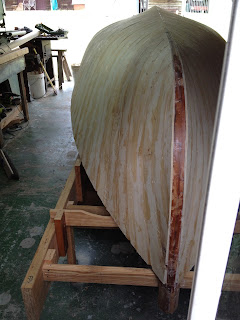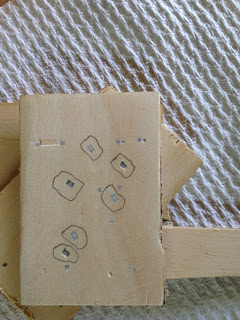A couple of weeks have passed since the last post and progress has been slow. Faced with the need to cut a lot of 100mm wide plywood strips I went looking for a small (tiny) circular saw with a fence. I found one with an 85mm diameter blade made by Worx. Here it is:
The saw part is quite good, light and easy to hold and the blade is narrow so less sawdust. The guide is a piece of crap! The black plastic guide is original, very narrow and difficult to keep against the edge of the sheet of ply. I added a pice of aluminium angle and this was a big improvement and showed up the next flaw - the guide is not parallel to the blade. There is no adjustment so I had to insert shims in various places to get the guide lined up. Now it works reasonably well.
While I was looking for the above I found and bought this device. I already had Ryobi batteries and chargers so the saw wasn't very expensive. It is hardly a boat building tool but it does an amazing job of pruning in the garden. I have a huge hedge to cut down and this saw makes the job so much easier.
Here's the set up for ripping the sheets into strips. The sheet is laid flat on a couple of trestles with a pair of 2x4s to support it. The first strips are easy to cut but the last 2 are a bit fiddly because the 2 clamps have to be moved to allow the saw to pass.
I ripped up 3 sheets of ply into 36 strips; this is probably enough to put one layer over about 2/3 of the hull. The two 2x4s on the bench are a "vice" to hold the strips vertical so I can plane the edges. One of the 2x4s is clamped to the bench and in use the ply strip is clamped between them.
Fixing the first few planks involved me in a steep learning curve. Each plank has to be fitted to its neighbour that is already in place. To do this it has to be clamped in place leaving a minimal gap and a line drawn on it parallel to the neighbour's edge. It is unclamped and trimmed to the line and then test fitted. It is very important that the plank lies flat on the mould while these steps are being done. If it isn't flat there is a twist in it and it will not fit nicely against the neighbour. Don't ask me how I know this!
I covered the mould with clear 50mm wide packaging tape so the planks would not be glued accidentaly to the frame. Having done that I raided the kitchen and covered the whole thing with cling film. This was a mistake because I had to cut through the film to clamp the planks in place while fitting them. I have removed the film from the areas I am working one.
This next photo shows the planking going on the other side of the boat. The nearest plank with the clamps is being marked along the edge to fit its neighbour; this process is called "spiling".
By this stage I have fitted 6 or 7 planks to both sides of the hull and have established a routine. Clamp, spile, unclamp, trim edge, test fit with clamps, trim if necessary, mix epoxy, prime all surfaces to be glued including the long edges which is a pain, thicken epoxy, apply thickened epoxy to one of all mating surfaces, put plank in place and nail to mould starting at the keel, add a clamp at the gunwale, clean up excess epoxy and make sure the joint between the planks is full of glue. This takes about 45 minutes.
By this stage I am using longer (16mm) plastic nails because the original 12mm ones didn't hold reliably where the curve was pronounced on the bilges. The clamp on the gunwale probably isn't necessary but I have to put it on to hold the plank while I am putting the last few nails in.
















